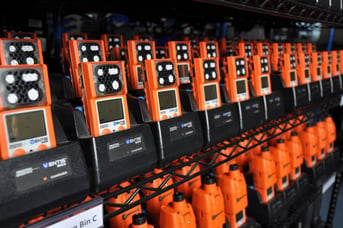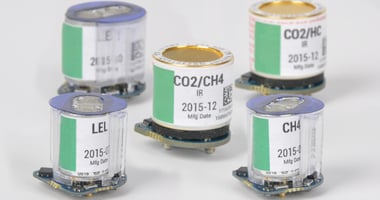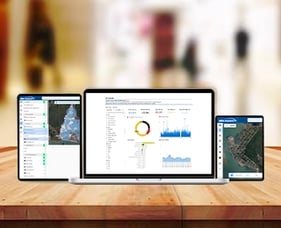 As industries worldwide pivot to adapt to the digital era, the concept of safety within the industrial sector has also undergone a shift of its own. Workplace safety is constantly evolving, and thanks to technological advancements, what was considered safe 10 or 20 years ago often doesn’t hold up to present-day safety standards.
As industries worldwide pivot to adapt to the digital era, the concept of safety within the industrial sector has also undergone a shift of its own. Workplace safety is constantly evolving, and thanks to technological advancements, what was considered safe 10 or 20 years ago often doesn’t hold up to present-day safety standards.
This is particularly true for gas detection systems. While up-to-date gas detection systems can’t eliminate every safety challenge, when paired with proper training, they can make industrial sites significantly safer for workers.
Safety measures to protect workers used to be as basic as a canary in a cage in some cases. Today, however, these safety measures are significantly more robust – featuring personal and area gas monitors that “speak” to each other via peer-to-peer communications and notify workers when their peers have fallen or been exposed to hazardous levels of toxic gases, as well as software solutions that provide real-time visibility and data into overall site health.
Real-Time Detection: Striking a Balance
Real-time gas detection today provides more precise indicators of hazardous conditions compared to canaries and is certainly more efficient than the old-school analytical methods of collecting air samples, sending them to a lab, and waiting for results. Yet, several applications dismiss the value of live monitoring.
Many would argue, for example, that analytical methods like collecting samples and sending them to a lab are the only acceptable means of performing personal gas exposure assessments. These arguments ignore that time is of the essence and lives may hang in the balance. There is tremendous value real-time information on gas hazards and immediate alerts for dangerous environments.
 A potential problem with real-time detection from portable devices is that it may give the user too much information, creating too much of an opportunity for complacency and human error that can lead to tragedy. Very rarely today is there a straightforward go/no go application involving a gas detector.
A potential problem with real-time detection from portable devices is that it may give the user too much information, creating too much of an opportunity for complacency and human error that can lead to tragedy. Very rarely today is there a straightforward go/no go application involving a gas detector.
That said, users need to be trained on how to react when their monitor enters a low alarm condition, and then what to do if it extends to a high alarm condition. Unfortunately, too often the instinct is to push through to finish the job when conditions are just past the alarm threshold. After all – there’s work to be done, and users are accustomed to regular beeping and flashing.
Monitors with datalogging capabilities are intended to provide safety professionals with even more information regarding their workers’ environments. A review of stored data often reveals hazards and alarm conditions that may have resulted in “near misses”; however, this may lead to more questions than answers.
These conditions can often go unrecognized or unreported because safety professionals lack visibility into what’s really happening in the field. In follow-up investigations, users rarely remember the instrument going into alarm, what they were doing at the time or where they were doing it.
Put simply, it’s difficult to eliminate hazards when the details behind them are lost in the data.
Live Monitoring Solutions: Tipping the Scales
In the current age of digital transformation, software solutions like the iNet platform have become the backbone of business operations. For safety managers, utilizing an integrated, comprehensive management software that combines various safety tasks, data, and functionalities into a single system can play a pivotal role in streamlining operations, improving efficiency, and pioneering safety.
As a result, real-time live monitoring is no longer a luxury but a necessity. The ability to monitor and respond to safety issues in real-time can significantly improve your connected safety setup. It enables you to detect potential threats and hazards early, thereby preventing incidents and reducing downtime.
 For example, a remote monitoring center can see where an instrument is being used, who is using it, and what conditions the monitor is currently being used in. Safety professionals or trained control room operators with higher decision-making capability can see trending readings from monitors and be notified immediately when hazardous conditions appear, so they can pull workers from the field, summon help, or notify emergency response personnel accordingly. Expanding real-time gas detection to include iNet live monitoring adds a safety blanket to users and reduces the decision-making burden on users.
For example, a remote monitoring center can see where an instrument is being used, who is using it, and what conditions the monitor is currently being used in. Safety professionals or trained control room operators with higher decision-making capability can see trending readings from monitors and be notified immediately when hazardous conditions appear, so they can pull workers from the field, summon help, or notify emergency response personnel accordingly. Expanding real-time gas detection to include iNet live monitoring adds a safety blanket to users and reduces the decision-making burden on users.
By finding an iNet solution that acts as a centralized hub for all safety-related tasks and information, users can eliminate the need for multiple, disparate systems. A centralized software hub like iNet Control+ can also streamline safety management processes, reduce downtime and alarm fatigue, improve compliance, and even mitigate risks with features like interactive device placement and alarm heat mapping.
These comprehensive safety management solutions offer a clear and detailed understanding of equipment, data, and worker behaviors. This level of visibility and control can significantly reduce the risk of safety incidents, ensure compliance with safety standards, and optimize operations through critical insights derived from the system.
By embracing such a software solution, you're able to enhance your safety setup, while fostering a proactive safety culture within your organization.
Interested in learning more about the entire iNet platform and what works for your unique needs? Click here to learn more and talk to an expert.



